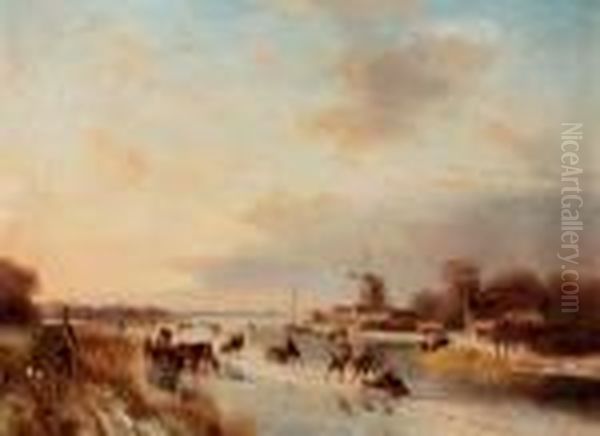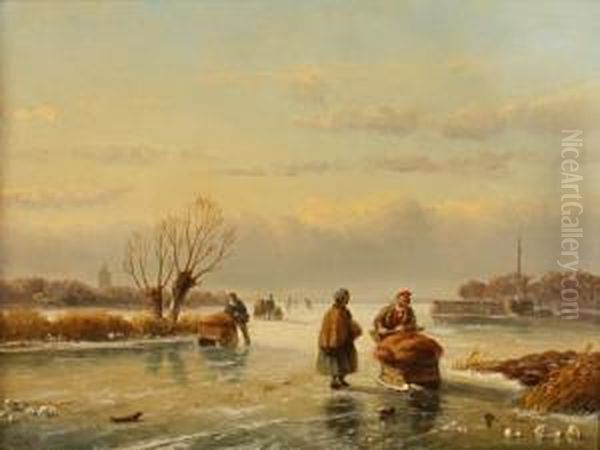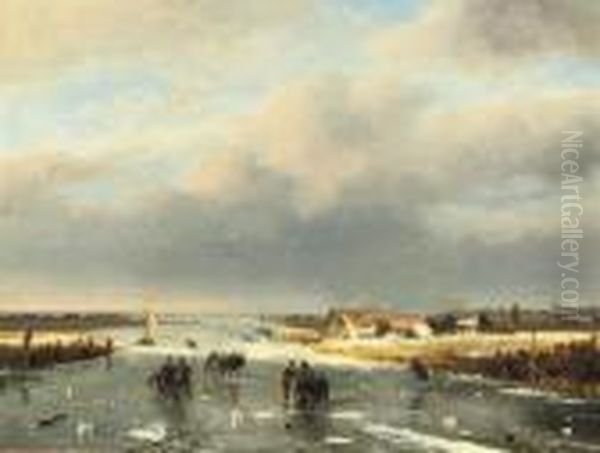Nicolaas Johannes Roosenboom (1805-1880) stands as a significant figure in the rich tradition of Dutch landscape painting, particularly renowned for his evocative and meticulously rendered winter scenes. Born in Schellingwoude, a village near Amsterdam, Roosenboom's life and career unfolded during a period of renewed appreciation for the national landscape, echoing the glories of the 17th-century Golden Age painters while imbuing his work with the sensibilities of 19th-century Romanticism. His legacy is defined by his ability to capture the crisp atmosphere, the playful human activity, and the serene beauty of the Netherlands under snow and ice.
Early Life and Artistic Formation
Nicolaas Johannes Roosenboom's artistic journey began in an environment conducive to creative pursuits. His most formative influence was undoubtedly his teacher, Andreas Schelfhout (1787-1870), one of the preeminent Dutch Romantic landscape painters of the era. Schelfhout was celebrated for his own winter landscapes, as well as summer scenes, and his tutelage provided Roosenboom with a strong foundation in technique and composition. Roosenboom absorbed Schelfhout's characteristic style, which often featured low, expansive horizons, a deep sense of spatial recession, and a remarkable attention to detail in rendering natural elements like trees, ice, and cloud formations.
The connection to Schelfhout was not merely professional but also personal. Roosenboom married Maria Schelfhout, his teacher's daughter, further cementing his ties to this artistic lineage. This familial connection likely provided both support and a continued immersion in the artistic currents championed by Schelfhout. From this esteemed master, Roosenboom learned to observe nature keenly and to translate those observations into paintings that were both topographically recognizable and emotionally resonant.
The Quintessential Dutch Winter
Roosenboom's oeuvre is most distinguished by his specialization in winter landscapes, a theme with deep roots in Dutch art, harking back to masters like Hendrick Avercamp (1585-1634) and Aert van der Neer (1603-1677). These 17th-century artists had established the winter scene, often populated with skaters and villagers, as a quintessential Dutch genre. Roosenboom masterfully revived and continued this tradition, adapting it to the tastes and sentiments of his own time.

His winter paintings are typically characterized by their depiction of frozen rivers, canals, and lakes, teeming with figures engaged in various winter activities – predominantly skating, which was a popular pastime and a recurring motif in Dutch art. Works such as "Skaters on a Frozen Waterway" or "Figures on a Frozen Lake" (titles often vary or are descriptive) exemplify his skill. He captured the specific quality of light in winter – sometimes crisp and clear, other times soft and diffused by a hazy sky. The reflections on the ice, the subtle gradations of white and grey in the snow, and the bare branches of trees silhouetted against the sky are all rendered with a delicate precision.
Roosenboom’s compositions often guide the viewer’s eye through a carefully constructed space, using the receding lines of a frozen waterway or a line of trees to create a sense of depth. The human figures in his landscapes, though small, are full of life and individual character, adding a narrative element and a sense of community to the scenes. These figures are not mere staffage; they are integral to the atmosphere, embodying the Dutch people's harmonious relationship with their often-challenging climate.
Artistic Style and Techniques
Roosenboom worked primarily in oil on canvas or panel, the preferred medium for achieving the smooth finish and detailed realism characteristic of his style. His brushwork was generally fine and controlled, allowing for a high degree of detail without sacrificing the overall atmospheric unity of the scene. He inherited from Schelfhout the ability to create convincing textures, whether it be the rough surface of a snow-covered bank, the slick sheen of ice, or the weathered wood of a nearby windmill or cottage.
His palette for winter scenes was, by necessity, somewhat restricted, dominated by whites, greys, blues, and browns. However, within this range, he achieved remarkable subtlety and variation. He often introduced touches of warmer color in the clothing of the figures or in the rosy glow of a winter sunset, providing focal points and enlivening the composition. The interplay of light and shadow was crucial, with Roosenboom skillfully depicting the long shadows cast in the low winter sun or the soft, even light of an overcast day.
While best known for his winter scenes, Roosenboom also painted summer landscapes, river views, and coastal scenes, demonstrating his versatility. His summer landscapes, though less numerous, show a similar attention to atmospheric effect and detailed rendering of foliage and water. He also explored other artistic mediums, including etching, lithography, and watercolor, showcasing a broad technical proficiency. His works were regularly exhibited in cities like Amsterdam and Brussels, gaining him recognition and a steady stream of patrons.
Context: Dutch Romanticism and its Roots

Roosenboom's art is firmly situated within the Dutch Romantic movement of the 19th century. Unlike the more dramatic and sublime Romanticism found in Germany with artists like Caspar David Friedrich (1774-1840), or the dynamic, elemental power seen in the work of Britain's J.M.W. Turner (1775-1851), Dutch Romanticism was generally more subdued and intimate. It often focused on the specific character of the Dutch landscape and the everyday life of its people.
This movement represented a resurgence of national pride in Dutch artistic traditions after a period of relative decline in the 18th century. Artists looked back to the 17th-century Golden Age masters like Jacob van Ruisdael (c. 1629-1682) and Jan van Goyen (1596-1656) for inspiration, emulating their naturalism and their dedication to depicting the local environment. Roosenboom and his contemporaries, such as Barend Cornelis Koekkoek (1803-1862), who was renowned for his majestic forest scenes and romantic landscapes, and Wijnand Nuijen (1813-1839), known for his dramatic coastal and river scenes, sought to capture the soul of the Netherlands.
Schelfhout, Roosenboom's teacher, was a key figure in this revival, and his influence extended to many other artists, including Charles Leickert (1816-1907), who also became known for his charming winter cityscapes and ice scenes, and Johannes Franciscus Hoppenbrouwers (1819-1866). These artists, while sharing a common Romantic sensibility and a debt to Schelfhout, each developed their own nuances. Roosenboom’s particular strength lay in the lyrical quality of his winter scenes and the sense of cheerful animation he brought to them.
Travels, Family, and Later Career
Due to his commercial success, Nicolaas Johannes Roosenboom enjoyed a degree of financial stability that allowed him to travel and move residences. Records indicate he moved at least fifteen times throughout his life. He undertook journeys to Germany, Italy, and the United Kingdom. While his core subject matter remained rooted in the Dutch landscape, these travels may have broadened his artistic perspective and exposed him to different artistic trends and landscapes, even if their direct influence on his typical Dutch scenes is not always overtly apparent.

His family life was intertwined with his artistic one. His marriage to Maria Schelfhout connected him to an established artistic dynasty. This connection likely facilitated his career and provided a supportive environment. The artistic talent continued into the next generation, as his daughter, Margaretha Roosenboom (1843-1896), became a celebrated painter in her own right, specializing in flower still lifes, a genre in which she achieved considerable acclaim, distinct from her father's landscape focus but sharing a similar dedication to meticulous observation and refined technique. Other notable painters of the period, though perhaps not in direct collaboration or competition, included figures like Salomon Verveer (1813-1876), known for his lively town and beach scenes, and Johannes Bosboom (1817-1891), famed for his atmospheric church interiors.
Throughout his career, Roosenboom maintained a consistent output, and his works found favor with collectors both in the Netherlands and abroad. The popularity of his winter scenes, in particular, spoke to a nostalgic appreciation for traditional Dutch life and landscape, an appeal that transcended national borders.
Representative Works and Their Characteristics
While specific titles can be elusive or vary, Roosenboom's body of work is identifiable by its consistent themes and stylistic features. A typical Roosenboom winter landscape might be titled "Winter Landscape with Skaters near a Windmill" or "Frozen River Scene with Figures."
One such archetypal work, often simply referred to as "Winter landscape with skaters," would likely depict an expansive frozen waterway under a luminous sky. In the foreground, groups of figures – men, women, and children – are shown skating, conversing, or pulling sleds. Their colorful attire provides vibrant accents against the snowy backdrop. A windmill, an iconic element of the Dutch landscape, might stand sentinel on the riverbank, its sails still. In the distance, the scene recedes towards a low horizon, perhaps with the silhouette of a distant village or a line of trees. The ice itself is rendered with great care, showing areas of smooth, reflective surface as well as rougher, snow-dusted patches. The overall impression is one of harmonious activity within a serene, beautifully observed natural setting.
Another example, perhaps "A Day on the Ice," would emphasize the communal aspect of these winter gatherings. One might see vendors selling refreshments, children playing, and people of all ages enjoying the crisp air. The composition would be carefully balanced, with the figures distributed across the ice in a way that feels natural yet aesthetically pleasing. The light, whether the bright sun of midday or the softer glow of late afternoon, would be a key element, defining forms and creating atmosphere. Works like "Unloading the Horsedrawn Sled on the Ice" would focus on specific activities, adding a narrative of daily work and life continuing even in the depths of winter.
His summer scenes, such as "Resting at the River," while less common, would showcase his ability to render lush foliage, calm waters, and the warmer light of the season, demonstrating that his skills were not limited to icy vistas. These works often feature pastoral elements, such as cattle grazing or figures resting by a riverbank, conveying a sense of bucolic tranquility.
Legacy and Market Reception
Nicolaas Johannes Roosenboom's paintings were popular during his lifetime and have remained sought after by collectors of 19th-century Dutch art. His work is represented in numerous private and public collections, including museums in the Netherlands. The enduring appeal of his art lies in its technical accomplishment, its charming subject matter, and its quintessential "Dutchness."
In the art market, Roosenboom's paintings, particularly his well-preserved and characteristic winter scenes, command respectable prices at auction. Auction houses like Sotheby's, Christie's, and Bonhams regularly feature his works. Prices can vary significantly based on size, condition, subject matter (winter scenes typically being more prized), and provenance. For instance, a smaller piece or a summer landscape might fetch a few thousand euros or pounds, while larger, more elaborate winter scenes with numerous figures can achieve tens of thousands, and occasionally, significantly more. For example, a work like "A winter landscape with figures skating" sold for €8,500 at Christie's, while estimates for more significant pieces like "A day on the ice" or "Unloading the Horsedrawn Sled on the Ice" have ranged from €29,750 up to €250,000 or more, reflecting the high regard in which his premium works are held.
His contribution to Dutch art lies in his skillful continuation and revitalization of the landscape tradition. He, along with his teacher Schelfhout and contemporaries like Koekkoek and Leickert, helped define the character of Dutch Romantic painting. They created images that were not only aesthetically pleasing but also resonated with a sense of national identity and a love for the particular beauty of the Dutch environment. Artists like Anton Mauve (1838-1888) and members of the Hague School, who came later in the 19th century, would build upon this renewed focus on landscape, though often with a more naturalistic or impressionistic approach, moving away from the polished detail of the Romantics.
Conclusion
Nicolaas Johannes Roosenboom was an artist who masterfully captured the spirit and atmosphere of the Dutch landscape, especially in its winter guise. As a student of the great Andreas Schelfhout, he inherited a tradition of meticulous craftsmanship and a deep appreciation for nature. His paintings of skaters on frozen canals, set against the backdrop of windmills and snow-covered villages, have become iconic representations of 19th-century Dutch Romanticism. They evoke a sense of nostalgia, community, and the enduring beauty of the Netherlands. Through his dedication to his craft and his chosen subject matter, Roosenboom secured his place as a beloved and important painter within the long and distinguished history of Dutch art, his works continuing to charm and captivate audiences well over a century after his passing. His influence, alongside that of painters like Willem Koekkoek (1839-1895), who specialized in townscapes, and marine painters like Johannes Christiaan Schotel (1787-1838), contributed to the rich tapestry of 19th-century Dutch art.